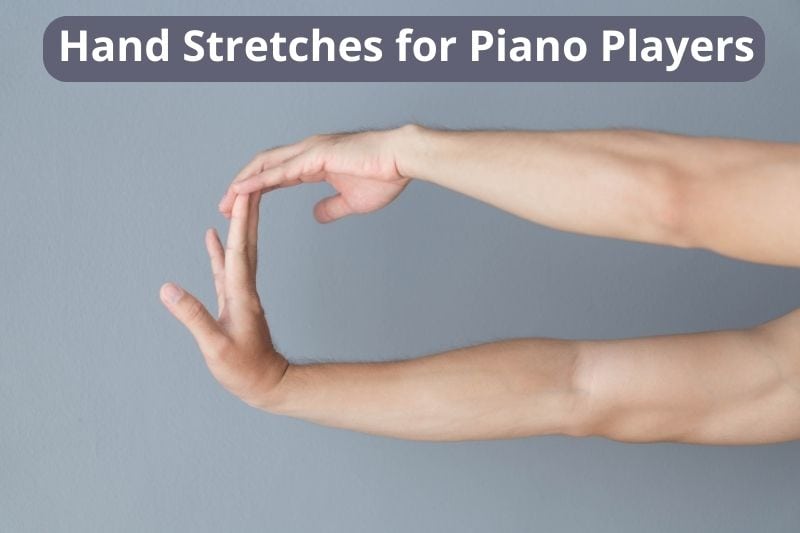Hand stretches are essential for pianists looking to improve their playing technique. As a pianist, you already know the importance of dexterity, strength, and flexibility in your fingers and hands.
Regularly incorporating hand stretches into your practice routine can enhance your ability to execute challenging passages and help prevent strain or injury. Playing the piano requires precise coordination and fine motor skills, and stretching properly ensures that your hands are primed for the demands of practicing and performing.

Understanding which stretches are beneficial can help you develop a routine that targets the muscles and tendons used most during play. Implementing a balanced mix of stretching exercises not only prepares your hands for the intricate demands of piano music but also lays the groundwork for improved hand coordination, which is vital for pianists at any level.
The Importance of Hand Stretches for Pianists
Stretching ensures you maintain flexibility and technique while also helping to prevent injury.
Benefits of Stretching for Pianists
- Improved Flexibility: Stretching your fingers, hands, and wrists increases your range of motion, enabling you to reach keys with ease and fluidity.
- Enhanced Technique: Regular stretches contribute to smoother transitions between notes and chords, refining your playing technique.
- Injury Prevention: Consistently stretching your hands can help ward off common musculoskeletal issues that musicians often face from repetitive movements.
Focusing on hand health is essential for long practice sessions and complex pieces that demand dexterity.
Common Hand and Wrist Injuries
- Tendonitis: Overuse of the wrists and fingers can lead to inflammation of the tendons, causing pain and hindering your ability to play.
- Carpal Tunnel Syndrome: Excess pressure on the median nerve in the wrist can lead to tingling, numbness, and weakness in the hand.
- Sprains and Strains: Without proper care, ligaments, and muscles can be overstretched or torn during vigorous playing.
Regular stretching, combined with adequate rest, is key to managing and preventing these common issues.
Basic Hand Stretching Techniques
To get started, focus on starting with a solid warm-up, followed by targeted exercises for your fingers and wrapping up with stretches for your wrists and arms.
Pre-Practice Warm-Up Routine
A thorough warm-up is key to prevent strain and improve your dexterity. Start by gently shaking your hands to increase blood flow, and then progress to rotating your wrists clockwise and counterclockwise to loosen the joints.
Finger Stretches and Exercises
Building muscle memory and finger strength is crucial for piano players. Begin with simple stretches, extending each finger individually while keeping the rest of the hand relaxed. Progress to alternating finger lifts on the piano keys, pressing down one while lifting the others.
- Finger Independence Drill
- Index to Pinky: Tap each finger in sequence, emphasizing independent movement.
- Contrary Motion: Tap fingers towards and away from each other, like a spider “walking” on the keys.
Wrist and Arm Stretches
For your wrists and arms, start with gentle wrist bends – extend your arm, palm down, and use your other hand to gently press down on the fingers, then switch to an upward stretch. Wrap up with arm stretches, reaching above your head and then touching your shoulder blades to engage the full range of arm muscles.
- Wrist Flexion and Extension
- Flex: With your elbow straight, gently bend your wrist downward.
- Extend: Then, point it upwards, applying slight pressure for a stretch.
These exercises should be done with care to avoid over-stretching.
Piano-Specific Stretching Exercises
Hand stretches tailored for piano players focus on improving flexibility, strength, and dexterity required for challenging pieces.
Scales and Arpeggios
Practicing scales and arpeggios is fundamental to developing finger strength and independence. Start with a simple 5-note scale in each hand, ensuring your fingers are relaxed and your movements are fluid.
- C Major Scale: Play with one hand at a time, then both together.
- A Minor Arpeggio: Focus on smooth transitions between the notes.
It’s important to gradually increase tempo without sacrificing accuracy.
Octave and Chord Stretches
Stretching exercises involving octaves and chords help in expanding your hand span and flexibility.
- Octave Reach: Play an octave scale, aiming for a clean sound while stretching between the thumb and pinky.
- Chord Press: Gently press down on a chord and hold for a few seconds. Start with triads and progress to seventh chords.
Always return to a relaxed hand position after each stretch.
Advanced Flexibility and Dexterity Drills
For more advanced players, dexterity drills can enhance your keyboard mastery.
- Thumb Under Drills: Practice passing the thumb under the fingers for fluid scale playing.
- Cross-Hand Arpeggios: These challenge your hand coordination and stretch capacity.
Integrate these drills into your daily practice to maintain and advance your technique.
Developing Finger Independence
Mastering finger independence is crucial for gaining control over each of your fingers, which ultimately improves your overall piano technique.
Exercise Routines for Finger Control
To develop finger independence, start with basic finger drills that challenge each finger’s strength and dexterity. Here is a suggested routine:
- Warm-up with finger stretching: Gently stretch each finger away from the others to increase flexibility.
- 5-finger scales: Play scales using only five notes (C to G and back down), focusing on even pressure and sound from each finger.
- Contrary motion exercises: Begin at Middle C with both thumbs and play scales moving in opposite directions. This will challenge your coordination and finger independence.
- Pinky strengthening drills: Your pinky finger is typically the weakest, so it’s important to exercise it separately. Play short staccato notes with just the pinky to build strength.
- Finger lifts: Hold down all fingers except for one, lifting each finger high and then striking a key firmly to train control. Repeat this for each finger.
As you incorporate these exercises into your daily practice routine, and with consistent effort, you’ll notice improved control and independence of your fingers on the piano.
Incorporating Hand Stretches into Practice Sessions
Integrating hand stretches into your daily practice is crucial for developing flexibility and preventing injuries.
Daily Stretching and Practice Schedule
To get the most out of your practice session, begin with 5-10 minutes of stretching. This prepares your hands and fingers for the piano. Here’s a schedule to incorporate into your daily routine:
- Warm-Up: Spend a few minutes warming up your wrists with gentle circular motions.
- Finger Stretches: Stretch each finger individually, holding for 5 seconds.
- Palm Stretches: Extend your fingers back to stretch the palm, holding for another 5 seconds.
- Practice: Follow your stretches with scales and etudes, using a metronome to keep a consistent tempo.
- Cool-Down: End your session with light stretches to relax your muscles.
Proper stretching, before you dive into heavier playing, can increase your endurance and improve your overall technique.
Progress Tracking and Increasing Difficulty
It’s important to track your progress and gradually increase the difficulty of your stretches and exercises. Use these strategies:
- Log Your Routine: Keep a daily log of your stretching and playing exercises.
- Gradually Increase Tempo: As you become more comfortable, incrementally increase the tempo of your scales and exercises.
- Use a Metronome: To ensure accuracy with tempo changes, always practice with a metronome.
- Expand Exercises: Once basic stretches are mastered, include more complex exercises that challenge your dexterity and strength.
Recovery and Rest for Optimal Performance
Your body’s ability to recover from practice sessions is crucial to prevent injuries and maintain steady progress. You need to manage rest times effectively and address discomfort that might arise from playing.
Balancing Practice and Rest
Your muscles need time to recover and adapt to the new demands you’re placing on them. Strike a balance between practice and rest by:
- Scheduling breaks during your practice sessions. For example, after every 30 minutes of practice, take a 5-minute break.
- Incorporating days off into your routine to allow for full recovery, one or two days a week, depending on your practice intensity.
Dealing with Pains and Strains
If you start feeling pain during practice, it’s a signal from your body that something’s off. Here’s how you can respond to ensure a safe recovery:
- Identify the issue: pay attention to what triggers the discomfort—whether it’s a certain piece or technique.
- Take immediate action: when you feel pain, stop playing to prevent further injury.
- Apply R.I.C.E.: Rest, Ice, Compression, and Elevation to manage minor strains.
- Seek professional help if pain persists to prevent conditions like carpal tunnel syndrome.
Your body’s response to piano practice is as individual as your playing style. Listen to it, and you’ll be setting the stage for years of healthy playing.



